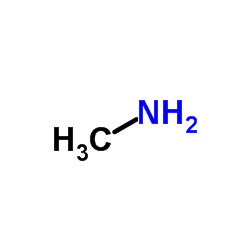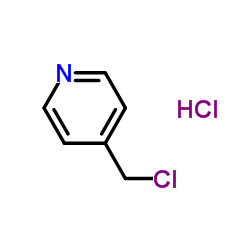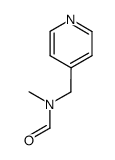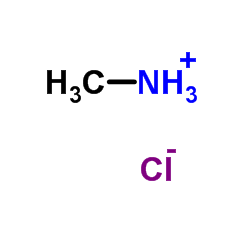6971-44-4
| Name | N-methyl-N-(4-pyridylmethyl)amine |
|---|---|
| Synonyms |
N-methyl-1-pyridin-4-ylmethanamine
N-Methyl-1-(4-pyridinyl)methanamine 4-Pyridinemethanamine, N-methyl- N-methyl-1-(pyridin-4-yl)methanamine MFCD00066937 N-METHYL-N-(4-PYRIDINYLMETHYL)AMINE METHYLPYRIDIN-4-YLMETHYLAMINE |
| Density | 1.0±0.1 g/cm3 |
|---|---|
| Boiling Point | 200.0±15.0 °C at 760 mmHg |
| Molecular Formula | C7H10N2 |
| Molecular Weight | 122.168 |
| Flash Point | 74.7±20.4 °C |
| Exact Mass | 122.084396 |
| PSA | 24.92000 |
| LogP | 0.03 |
| Vapour Pressure | 0.3±0.4 mmHg at 25°C |
| Index of Refraction | 1.515 |
Synonym:None Known Section 2 - COMPOSITION, INFORMATION ON INGREDIENTS
Risk Phrases: 34 Section 3 - HAZARDS IDENTIFICATION EMERGENCY OVERVIEW
Causes burns. Potential Health Effects Eye: Causes eye burns. Skin: Causes skin burns. Ingestion: Causes gastrointestinal tract burns. Inhalation: Causes chemical burns to the respiratory tract. Chronic: Chronic exposure may cause effects similar to those of acute exposure. Section 4 - FIRST AID MEASURES Eyes: In case of contact, immediately flush eyes with plenty of water for at least 15 minutes. Get medical aid immediately. Skin: In case of contact, immediately flush skin with plenty of water for at least 15 minutes while removing contaminated clothing and shoes. Get medical aid immediately. Wash clothing before reuse. Ingestion: If swallowed, do NOT induce vomiting. Get medical aid immediately. If victim is fully conscious, give a cupful of water. Never give anything by mouth to an unconscious person. Inhalation: Get medical aid immediately. Remove from exposure and move to fresh air immediately. If breathing is difficult, give oxygen. Do NOT use mouth-to-mouth resuscitation. Notes to Physician: Section 5 - FIRE FIGHTING MEASURES General Information: As in any fire, wear a self-contained breathing apparatus in pressure-demand, MSHA/NIOSH (approved or equivalent), and full protective gear. During a fire, irritating and highly toxic gases may be generated by thermal decomposition or combustion. Extinguishing Media: Use water spray, dry chemical, carbon dioxide, or appropriate foam. Section 6 - ACCIDENTAL RELEASE MEASURES General Information: Use proper personal protective equipment as indicated in Section 8. Spills/Leaks: Absorb spill with inert material (e.g. vermiculite, sand or earth), then place in suitable container. Avoid runoff into storm sewers and ditches which lead to waterways. Clean up spills immediately, observing precautions in the Protective Equipment section. Provide ventilation. Section 7 - HANDLING and STORAGE Handling: Do not breathe dust, vapor, mist, or gas. Do not get in eyes, on skin, or on clothing. Keep container tightly closed. Do not ingest or inhale. Discard contaminated shoes. Use only with adequate ventilation. Storage: Keep container closed when not in use. Store under an inert atmosphere. Section 8 - EXPOSURE CONTROLS, PERSONAL PROTECTION Engineering Controls: Facilities storing or utilizing this material should be equipped with an eyewash facility and a safety shower. Use adequate ventilation to keep airborne concentrations low. Exposure Limits CAS# 6971-44-4: Personal Protective Equipment Eyes: Wear appropriate protective eyeglasses or chemical safety goggles as described by OSHA's eye and face protection regulations in 29 CFR 1910.133 or European Standard EN166. Skin: Wear appropriate protective gloves to prevent skin exposure. Clothing: Wear appropriate protective clothing to prevent skin exposure. Respirators: A respiratory protection program that meets OSHA's 29 CFR 1910.134 and ANSI Z88.2 requirements or European Standard EN 149 must be followed whenever workplace conditions warrant respirator use. Section 9 - PHYSICAL AND CHEMICAL PROPERTIES Physical State: Liquid Color: colorless Odor: slight pH: Not available. Vapor Pressure: Not available. Viscosity: Not available. Boiling Point: 86 deg C @ 3mmHg Freezing/Melting Point: Not available. Autoignition Temperature: Not available. Flash Point: Not available. Explosion Limits, lower: Not available. Explosion Limits, upper: Not available. Decomposition Temperature: Solubility in water: Specific Gravity/Density: Molecular Formula: C7H10N2 Molecular Weight: 122.17 Section 10 - STABILITY AND REACTIVITY Chemical Stability: Stable at room temperature in closed containers under normal storage and handling conditions. Conditions to Avoid: None reported. Incompatibilities with Other Materials: Oxidizing agents, acids, acid chlorides. Hazardous Decomposition Products: Carbon monoxide, oxides of nitrogen, carbon dioxide. Hazardous Polymerization: Has not been reported. Section 11 - TOXICOLOGICAL INFORMATION RTECS#: CAS# 6971-44-4 unlisted. LD50/LC50: Not available. Carcinogenicity: N-Methyl-N-(4-pyridinylmethyl)amine - Not listed by ACGIH, IARC, or NTP. Section 12 - ECOLOGICAL INFORMATION Ecotoxicity: Fish: Pseudomonas putida: Section 13 - DISPOSAL CONSIDERATIONS Dispose of in a manner consistent with federal, state, and local regulations. Section 14 - TRANSPORT INFORMATION IATA Shipping Name: AMINES, LIQUID, CORROSIVE, N.O.S. Hazard Class: 8 UN Number: 2735 Packing Group: III IMO Shipping Name: AMINES, LIQUID, CORROSIVE, N.O.S. Hazard Class: 8 UN Number: 2735 Packing Group: III RID/ADR Shipping Name: AMINES, LIQUID, CORROSIVE, N.O.S. Hazard Class: 8 UN Number: 2735 Packing group: III Section 15 - REGULATORY INFORMATION European/International Regulations European Labeling in Accordance with EC Directives Hazard Symbols: C Risk Phrases: R 34 Causes burns. Safety Phrases: S 6 Keep under nitrogen. S 36/37/39 Wear suitable protective clothing, gloves and eye/face protection. WGK (Water Danger/Protection) CAS# 6971-44-4: No information available. Canada None of the chemicals in this product are listed on the DSL/NDSL list. CAS# 6971-44-4 is not listed on Canada's Ingredient Disclosure List. US FEDERAL TSCA CAS# 6971-44-4 is not listed on the TSCA inventory. It is for research and development use only. SECTION 16 - ADDITIONAL INFORMATION N/A |
| Hazard Codes | Xi |
|---|---|
| Risk Phrases | 22-34 |
| Safety Phrases | 23-26-36/37/39-45 |
| RIDADR | 2922 |
| HS Code | 2933399090 |
|
~% 
6971-44-4 |
| Literature: WO2006/80954 A1, ; Page/Page column 80 ; |
|
~% 
6971-44-4 |
| Literature: Journal of Medicinal Chemistry, , vol. 38, # 11 p. 1892 - 1903 |
|
~% 
6971-44-4 |
| Literature: Journal of Medicinal Chemistry, , vol. 38, # 11 p. 1892 - 1903 |
|
~71% 
6971-44-4 |
| Literature: Zara-Kaczian, Erzsebet; Deak, Gyula; Gyoergy, Lajos Acta Chimica Hungarica, 1989 , vol. 126, # 4 p. 441 - 454 |
|
~% 
6971-44-4 |
| Literature: Tetrahedron Letters, , vol. 26, # 48 p. 5863 - 5866 |
|
~% 
6971-44-4 |
| Literature: Tetrahedron Letters, , vol. 26, # 48 p. 5863 - 5866 |
|
~% 
6971-44-4 |
| Literature: Tetrahedron Letters, , vol. 26, # 48 p. 5863 - 5866 |
|
~% 
6971-44-4 |
| Literature: Archiv der Pharmazie (Weinheim, Germany), , vol. 320, # 7 p. 647 - 654 |
| Precursor 8 | |
|---|---|
| DownStream 0 | |
| HS Code | 2933399090 |
|---|---|
| Summary | 2933399090. other compounds containing an unfused pyridine ring (whether or not hydrogenated) in the structure. VAT:17.0%. Tax rebate rate:13.0%. . MFN tariff:6.5%. General tariff:20.0% |








